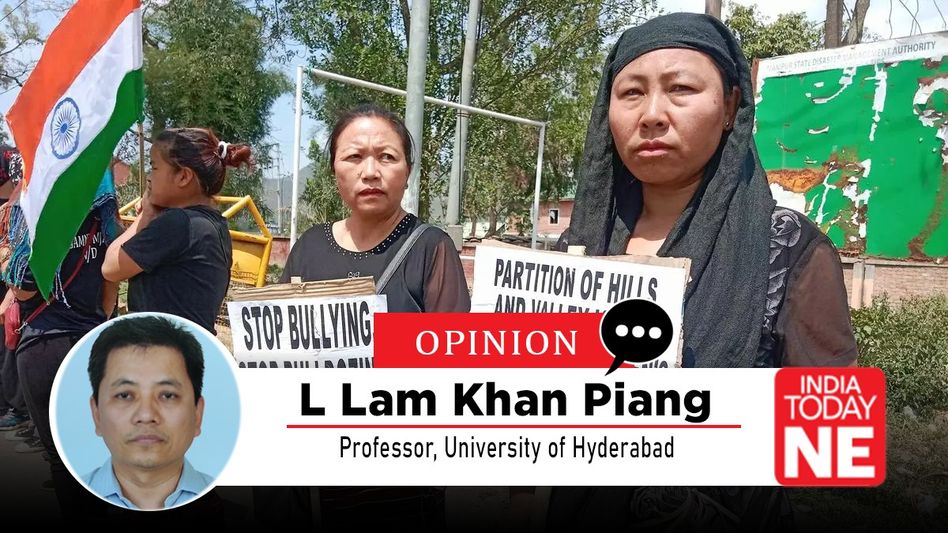‘Settlerizing the others’ and labeling as criminal: Schematic majoritarian assertion in Manipur
When the violence continues unabated in the presence of the state and central forces for more than 147 days, it can either be the complicity or the incompetency of the state in the majoritarian assertion.
 ‘Settlerizing the others’ and labeling as criminal: Schematic majoritarian assertion in Manipur
‘Settlerizing the others’ and labeling as criminal: Schematic majoritarian assertion in ManipurPrior to the escalation of the 3rd May mayhem in other parts of Manipur, a series of incidents unfolded at border villages, on the sides of Tedim Road, between hill and valley districts.
First, the Meitei organized road blockade between Churachanpur (Lamka) and Imphal starting from the 2nd May and harassed tribals travelling on this particular road in response to the plan to organise the ‘Tribal Solidarity March,’ scheduled to be held on the next day; Second, the burning of the ‘Anglo-Kuki War Centenary Memorial Gate’ by Meitei miscreants around 2:00 pm on 3rd May; Third, ambush of participants of the said rally on their way home by Meitei miscreants and killed one; Fourth, after continuous failure to provoke the tribals, the miscreants resorted to burning of the tribal houses at border area that resulted into retaliation and counter retaliation, and escalated to other places. Looking at how the so-called ‘organised miscreants’ tried hard to provoke the hill tribes, one cannot help but be suspicious of what the bigger game plan could be.
When the violence continues unabated in the presence of the state and central forces for more than 147 days, it can either be the complicity or the incompetency of the state in the majoritarian assertion.
Since the second inning of the Biren Singh government in the state in 2022, there has been a systematic pattern of labelling the Kuki-Zomi tribes, the target community of Manipur violence, even before the ongoing violence with certain derogatory tags to mainly achieve two objectives: ‘othering’ them and stigmatizing with criminalizing remarks. The former led to the construction of false narrative with the campaign to label them as refugees or illegal immigrants. The latter is done with the intention of criminalizing the target community, which led to the generalization of the entire community as poppy cultivators and narco-terrorists. It can be observed that the agenda of ‘othering of the target community’ was first initiated and followed by the process of ‘criminalizing the others’ (the Kuki-Zomi tribes).
Also Read: How people in my constituency saved a Kuki locality from hatred and destruction
The questions arise as to why such an agenda has been carried out by the dominant community? Why does it turn into a form of ethnic cleansing? Could it be possible without the violence continuing unabated for more than four months without the complicity of the state? In dealing with this question, first it is required to address the chorus of the Meitei complaint, which is about the land pressure issue i.e., the valley covers only 10% of the total geographical areas in which every citizen of India can settled, whereas the remaining 90% is hill areas in which land ownership is only reserved for the scheduled tribes. And that 90 per cent land consists of mountains, gorges and forests. It is also a fact that, there is no khas land or wasteland in the hill areas, the entire space is divided into numerous village lands and their ownership is either with the village chief or community (or clan in some Naga villages), except for the reserved forest declared before Indian independence by the British colonial government after they annexed the hill areas into the colonial Manipur.
Given the historical facts, to deal with the insecurity (fabricated or real) of the Meitei majority community, also the dominant one, their civil society organizations initiated a social movement demanding for the extension of the Inner Line Permit system (ILPS) in Manipur in the late 1980s, which was resurgent again in the first decade of the 21st century. To convince the masses for the cause as well as justifying this movement, the Meitei civil society initiated an insecurity campaign and reiterating the lack of management mechanism into the influx of migrants in Manipur. The Conglomerate of Meitei CSOs formed the Joint Committee for ILPS (JCILPS) in 2012 to spearhead the movement, which resulted in the passing of the controversial Three Bills in 2015. The hill tribes protested as they considered that the bills have potential to infringe their land rights. Though the bills were sent to the President of India, no assent was given. However, in 2019 the government of India acceded to the demand for the extension of ILPS in Manipur vide Order of the President of India [No. S. O. 4433(E) dated 11/12/2019] due to the sustained movement.
The success of the ILPS movement has encouraged the Meitei to continue to work on the land issue. For that matter, the demand for the Scheduled Tribes status for the Meitei has been geared up, whereas the government of Manipur resorted to the demolition of houses and churches considered to be encroaching government land in the valley and protected forest land in the hill areas. One of the cases was the Churachandpur-Khoupum protected forest, which can be considered as one of the reasons for the spiraling of tension among the hill tribes. This protected forest was notified vide No. 55/10/66-M (2) dt. 17.9.1966 without properly following the procedure laid down in Section 29 of the India Forest Act, 1927, which said that the State government made declaration to “any forest-land or waste-land which is not included in a reserved forest, but which is the property of Government, or over which the Government has proprietary rights”. However, it was declared over the private land of the tribal village chiefs, though they objected to the declaration and even the cases were already disposed of, it was reopened by the present Manipur government and canceled the order that excluded 38 villages that had objected to the declaration of protected forest over their land, in its cabinet meeting dated 13.10. 2022.
To create a congenial atmosphere for such activities and justify them, the labelling of the target community as refugees or illegal immigrants was initiated, which became the official line as well. Such labeling and allegation that the Kuki-Zomi are illegal immigrants (refugees) is supported neither by the historical records nor the census of India’s data, not even by the findings of the Biren Singh government’s cabinet sub-committee assigned to look into the problem of immigrants after the military coup in Myanmar in 2021. In the midst of such tragedy, it is disheartening to know that even the Chief Minister is indulging ‘othering’ as well as ‘settlerizing’ the entire Kuki-Zomi tribes in the colonial constructed Manipur. Settlerizing is defined here as the baseless allegation of an indigenous community as migrants or immigrants and labeling them as settlers with an intention to disassociate them with their own ancestral homeland and their history. What happened to the Kuki-Zomi tribes is alarming, as the allegation has been done knowingly to mitigate the tension built up as a result of demolition of houses in the protected forest areas and churches in the government land, as claimed by the government. The allegation is continued, perhaps to justify the unabated ethnic cleansing with genocide intent.
Such an exercise that intended to disassociate the Kuki-Zomi tribes with their history, as a part of the settlerizing process, can be discerned when FIR was lodged against the authors of the book, Anglo-Kuki War (1917-1919). This explains why the said centenary memorial gate was burnt, as it speaks the history of the resistance movement of the Kuki-Zomi tribes against the British empire and their sacrifices in protecting their ancestral territory. It must be one of the longest wars that the British had fought in South and South East Asia spending 28 lakhs of rupees (Reid, 1942:75). The British records it as Kuki rising, Kuki rebellion or Kuki uprising (or locally called Zo Gal), but the Kukis considered it an Anglo-Kuki war.
Of course, if the dominant community or the state intended to label a particular community as refugees, it is understandable as such action is prerequisite for a project attempting to erase the history of the minority community. It can be discerned through what Frank Stokes, a character in a movie, the Monument Men (2014), said, “You can wipe out an entire generation, you can burn their homes to the ground and somehow they'll still find their way back. But if you destroy their history, you destroy their achievements and it's as if they never existed.”
One can conclude that the burning of the centenary memorial gate by the organised miscreants is nothing but an attempt to destroy the history of the Kuki-Zomi tribes, as it reminded their existence as a different political as well as territorial entity from the Manipur Raja before the advent of the British colonizers. Further, the memorial gate represents the historical event that negates the labelling of the Zo indigenous people as refugees by the concocted majoritarian narrative of the dominant community.
For those who are eagerly waiting for the violence to end, it is reassuring to hear the Home Minister's speech in the parliament that Chief Minister Biren Singh is “cooperating.”In retrospect, though one wonders what that cooperating meant in the real sense of the term. Hope this is not hope against hope for those IDPs languishing in the relief camps, for those families whose loved ones’ bodies are still lying in Imphal’s hospital Morgues, and for those students whose dreams are shattered. And, undoubtedly, if the “cooperation” of the CM is for bringing peace in the ‘war torn’ Manipur, the violence would have stopped a long time ago.
Copyright©2025 Living Media India Limited. For reprint rights: Syndications Today









